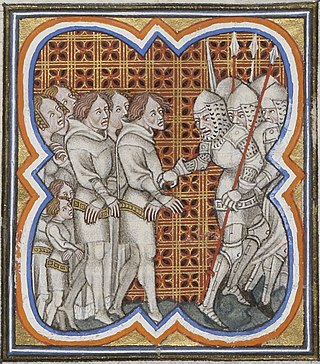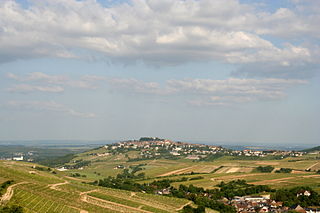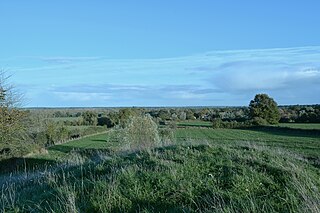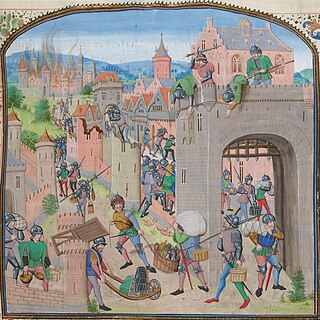
Edward of Woodstock, known to history as the Black Prince, was the eldest son of King Edward III of England, and the heir apparent to the English throne. He died before his father and so his son, Richard II, succeeded to the throne instead. Edward nevertheless earned distinction as one of the most successful English commanders during the Hundred Years' War, being regarded by his English contemporaries as a model of chivalry and one of the greatest knights of his age.

Charles VIII, called the Affable, was King of France from 1483 to his death in 1498. He succeeded his father Louis XI at the age of 13. His elder sister Anne acted as regent jointly with her husband Peter II, Duke of Bourbon until 1491 when the young king turned 21 years of age. During Anne's regency, the great lords rebelled against royal centralisation efforts in a conflict known as the Mad War (1485–1488), which resulted in a victory for the royal government.

The Jacquerie was a popular revolt by peasants that took place in northern France in the early summer of 1358 during the Hundred Years' War. The revolt was centred in the valley of the Oise north of Paris and was suppressed after over two months of violence. This rebellion became known as "the Jacquerie" because the nobles derided peasants as "Jacques" or "Jacques Bonhomme" for their padded surplice, called a "jacque". The aristocratic chronicler Jean Froissart and his source, the chronicle of Jean le Bel, referred to the leader of the revolt as Jacque Bonhomme, though in fact the Jacquerie 'great captain' was named Guillaume Cale. The word jacquerie became a synonym of peasant uprisings in general in both English and French.

Peter I of Bourbon was the second Duke of Bourbon, from 1342 to his death. Peter was son of Louis I of Bourbon, whom he also succeeded as Grand Chamberlain of France, and Mary of Avesnes.

Charles II, Duke of Bourbon, was Archbishop of Lyon from an early age and a French diplomat under the rule of Louis XI of France. He had a 2-week tenure as Duke of Bourbon in 1488, being ousted afterward by his younger brother and successor, Peter II, Duke of Bourbon.

Margaret of Valois, Duchess of Berry was Duchess of Savoy by marriage to Duke Emmanuel Philibert of Savoy. She was the daughter of King Francis I of France and Claude, Duchess of Brittany.

Antoine de la Sale was a French courtier, educator and writer. He participated in a number of military campaigns in his youth and he only began writing when he had reached middle age, in the late 1430s. He lived in Italy at the time, but returned to France in the 1440s, where he acted as umpire in tournaments, and he wrote a treatise on the history of the knightly tournament in 1459. He became the tutor of the sons of Louis de Luxembourg, Count of Saint-Pol, to whom he dedicated a moral work in 1451. His most successful work was Little John of Saintré, written in 1456, when he was reaching the age of seventy.

Sancerre is a medieval hilltop town (ville) and commune in the Cher department, France overlooking the river Loire. It is noted for its wine.

Agnes of Burgundy, duchess of Bourbon (Bourbonnais) and Auvergne, countess of Clermont, was the daughter of John the Fearless (1371–1419) and Margaret of Bavaria. Her maternal grandparents were Albert I, Duke of Bavaria and Margaret of Brieg. Her paternal grandparents were Philip the Bold and Margaret III, Countess of Flanders.

The Lords of Coucy, also spelt Couci, were a medieval lordship based on the barony of Coucy located in the current commune of Coucy-le-Château-Auffrique, Picardy. The château de Coucy was founded by Hervé, archbishop of Rheims, and remained under the fluctuating control of these archbishops for some time until probably the later part of the 10th century. The exact status of Coucy becomes obscure for nearly a century before the emergence of Lord Aubrey, Earl of Northumbria. Though the Lords of Coucy were entitled to the title of baron, they preferred the rarer Sire.
Arnaud de Cervole, also de Cervolles, de Cervolle, Arnaut de Cervole or Arnold of Cervoles, known as l'Archiprêtre, was a French mercenary soldier and Brigand of the Hundred Years War in the 14th century.

Bagneux is a commune of the Allier department in the Auvergne-Rhône-Alpes region of central France.
Germigny-l’Exempt is a commune in the central French department of Cher.
The House of Montoire, started with Nihard, Lord of Montoire. Later, through the marriages of Plaisante de Montoire and Helvise Doubleau, the possessions of Mondoubleau and Fréteval Langeais were added. The manor of Mondoubleau and, following the marriage of Pierre II de Montoire and Agnès de Vendôme, the county of Vendôme became part of the House of Montoire.

The Château d'Acquigny is a French castle located in the department of Eure in Upper Normandy.

Perin de Sasine, known by his alias Le Petit Meschin, was a French soldier, mercenary and brigand of the Hundred Years War in the 14th century.

Bernard de la Salle, was a French mercenary captain during the Hundred Years War. His story is mentioned in the Chronicles of Froissart
Bernard de Wisk was a mercenary captain and sometime brigand of the Hundred Years War.

Bour Camus, or Camus Bour Lesparre, also known as Camus the Bastard was a mercenary captain during the Hundred Years War. He was of Navarrese or Gascon origin.

Bertucat d'Albret was a medieval mercenary leader of a bandit army in the Hundred Years' War.














